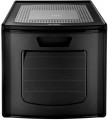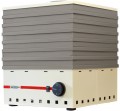Type
–
Vertical fruit dryer. Vertical models of dryers involve loading vegetables and fruits on perforated trays, which are placed one above the other in several tiers. The heating element and the fan in their design are at the bottom, and hot air is blown from the bottom up. As a result, products on the lower shelves dry much faster than those on the upper levels. During the drying process, it is often necessary to swap the upper and lower trays. In many instances of vertical dryers, this disadvantage is eliminated due to the successful shape of the pallets.
—
Dehydrator (horizontal dryer). Horizontal dehydrators are better than vertical ones. Often they are made in the image and likeness of small ovens with pull-out trays to place products. Hot air in the oven of the horizontal type dryers is blown by a fan, which is installed on the rear wall perpendicular to the trays with vegetables and fruits. Horizontal airflow ensures uniform drying of products at all levels. However, the pricing policy for devices of this order is more “biting”.
Drying levels
The number of separate trays on which food can be placed during drying.
The design of the trays in food dryers can vary. Typically, they consist of separate closed compartments, but another option is a common chamber with shelves (refer to the "Location of the fan (heater)" section for more information). Regardless of the specific design, the trays are positioned vertically, with multiple trays or "floors" in modern food dehydrators. The most modest option is actually
3 trays;
4 trays — also quite a small number;
5-tray dehydrators are the most popular; noticeably less common models with
6 trays or
8 trays; and in individual devices
9 or more trays can be provided (12, and sometimes 20).
Using multiple trays or "floors" in a food dehydrators ffers several advantages. It allows for increased capacity while maintaining a compact width and depth for the entire device. The more tiers there are, the smaller the area of each individual tray becomes, enabling a smaller overall width and depth of the dehydrator. This is particularly beneficial when space is limited on a table or surface, but there is ample vertical space available. Additionally, having multiple trays allows for simultaneous drying of different types of products with varying drying times. By using ce
...rtain techniques, individual compartments and shelves can be removed without having to turn off the device. However, it's important to note that increasing the number of levels in the device affects its height and cost, reduces the capacity of each individual tray, and necessitates the use of more powerful fans to ensure even heat distribution.
It's important to note that the presence of numerous trays does not necessarily indicate a powerful or spacious food dehydrator. This design can be found in compact models as well. Devices with 3-4 tiers often do not significantly differ in capacity, although there may be exceptions to this.
At the same time, there are also models whose equipment with trays significantly exceeds the number of drying levels. But our paragraph indicates how many levels (trays) can be used simultaneously when drying.Tray size
Horizontal dimensions of one dryer tray.
For round models, this paragraph usually indicates the diameter (for example, “Ø250”), for other cases — the length and width. Anyway, the information about the size allows you to estimate the total area and, accordingly, the capacity of the device. At the same time, note that a larger size affects the dimensions and weight of the structure, and also requires more heating power (ceteris paribus).
Tray height
The size of one tray of the dryer in height. In models where, instead of separate trays, a common working chamber with removable shelves is provided, the distance between two adjacent shelves is indicated.
This size primarily determines the thickness of individual pieces of vegetables, fruits, etc., which can be placed in the device. At the same time, note that the contents should not fill the tray tightly — there should be at least a couple of millimetres of space between the products and the “ceiling”. Also note that in some models, two height values can be indicated in this paragraph — for example, “15 — 25 mm”. This means that the size of the trays can be changed, adjusting them to the specifics of the situation; usually it is a choice between two standard heights (in our example — 15 mm and 25 mm).
Total capacity
The total volume of all dryer trays. The larger the volume, the more products can be loaded into the device at a time. For modern dryers, a capacity of
up to 10 L is considered relatively small,
from 11 to 15 L — medium,
from 16 to 20 L — high, and the largest models can hold
more than 20 L.
Note that if you plan to dry several different types of fruits or vegetables at the same time, it is worth considering not only the total volume of the dryer, but also the number of trays (see above).
Power consumption
Rated power consumed by the dryer during operation.
This parameter is usually selected by manufacturers depending on the volume of the dryer: the larger the device, the more power is needed to effectively heat the working chamber. At the same time, models with the same volume may differ in power consumption. In such cases, it is worth considering that a higher power reduces the heating time, but affects the price of the device.
Mesh for herbs and spices
A mesh for herbs and spices is included in the delivery set of the food dehydrator.
These meshes are characterized by a finely porous structure to prevent herbs and spices from falling through the mesh holes. They are made of silicone or stainless steel, and more rarely of bamboo. There are also variants with non-stick coating, which prevents food from sticking to the surface of the mesh.
Temperature range
The temperature range that the dryer can provide in the working chamber.
The simplest models provide only one operating temperature option, usually from 50 °C to 60 °C. More advanced devices equipped with thermostats (see above) and can have a wide range of adjustment — this is very useful, because different temperature regimes are recommended for different products. To assess the general capabilities of a particular dryer, you can use the following table of temperatures recommended for drying:
— 35...40 °C — plant stems, greens;
— 40...45 °C — bread;
— 38...42 °C (in some cases up to 45 °C) — yoghurt;
— 50...55 °C — vegetables;
— 55...60 °C — fruits;
— 65...75 °C — meat, fish.
We emphasize that these are the most general, conditional data. The specific temperature may differ from the recommended one — depending on the thickness of the slices, the specific type of food, the desired result, etc. Detailed recommendations on this matter can be found in special sources.
Location of the fan (heater)
The location of the heating element (fan with heater) installed in the food dehydrator. This element can be installed at the
bottom,
top or
behind, here are the features of each of the options:
— Bottom. The classic and most common arrangement for heaters in food dehydrators is located at the bottom. This design choice offers two main advantages. Firstly, warm air is evenly distributed throughout the dryer's volume as it rises from the bottom. Secondly, these devices have compact dimensions in terms of width and depth, which are mainly determined by the size of the trays. This allows for more flexibility in terms of placement options. However, a potential drawback of the lower heater placement is the possibility of contamination, which can result in unpleasant odors. In such cases, disassembling and thoroughly cleaning the dryer may be required. Nonetheless, most manufacturers take steps to address this issue, making it less of a critical concern.
— Top. The safest location for the heater in a food dehydrator is considered to be at the top, as it minimizes the risk of moisture from the dried products coming into contact with the heater. Similar to the previously mentioned design, the width and depth of the food dehydrator do not exceed the size of the trays. However, dehydrators with a top-mounted heater may not provide uniform heating. Warm air tends t
...o accumulate in the upper part of the device, resulting in the upper trays being heated more than the lower ones. In theory, this can be advantageous for drying products that require different temperature conditions, as higher-temperature items can be placed higher in the dehydrator. However, in practice, it is challenging to account for the actual temperature difference accurately. This aspect becomes a clear disadvantage when drying uniform ingredients, as it requires periodic rearrangement of the trays to achieve even processing. As a result, there are fewer models with a top-mounted heater available nowadays.
— Behind. Food dehydrators in this category have a layout that differs from the previously described options. They resemble ovens with baking sheets, where a common working chamber is used instead of separate trays stacked on top of each other. Inside the chamber, lattice shelves are fixed with special slots or protrusions on the walls. The heater is located at the back of the "oven". This design is considered highly advanced, as it allows for easy removal and placement of individual trays without disturbing the others. It also provides very uniform heating and minimizes the mixing of odors between different levels. Moreover, the lattice shelves can be rearranged to increase the height of specific "trays". However, the drawbacks of models with a rear heater include their bulkiness and higher cost. As a result, this layout option is primarily used in semi-professional and higher-level food dehydrators.
